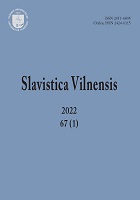Pol. zielony a lit. žalias: prototypy i konotacje
Polish zielony and Lithuanian žalias: Prototypes and Connotations
Author(s): Viktorija UšinskienėSubject(s): Semantics, Comparative Linguistics, Western Slavic Languages, Baltic Languages
Published by: Vilniaus Universiteto Leidykla
Keywords: green color; semantic prototypes and connotations; contrastive analysis;
Summary/Abstract: The paper presents the results of the contrastive semantic analysis of the Polish lexeme zielony ‘green’ and its Lithuanian equivalent žalias. The research based on the methodology of R. Tokarski and K. Waszakowa is aimed at comparing the collocability of Pol. zielony / Lith. žalias with names of various objects and phenomena (both in the literal and figurative senses) including the identification of the prototype references and connotative meanings. The analysis has illustrated that in both languages, ‘green’ is interpreted primarily as the color of grass or other plants, but for some shades of green, the color of certain minerals (such as emerald or malachite) can be considered a prototype pattern. Common prototypical references clearly motivate similar symbolic and cultural values of Polish and Lithuanian terms. Pol. zielony / Lith. žalias have similar ranges of use and develop quite convergent connotative meanings, of which there are slightly more in Lithuanian. In both languages, the prototype association with the green of young plants creates the following connotational meanings: ‘young’, ‘fresh’, ‘unripe’, ‘immature’, ‘inexperienced’, ‘healthy’, ‘ecological’. Both in Polish and in Lithuanian, some shades of green can connote not only positive but also negative characterizations, based on associations with the chthonic world or with disease and death. However, such connotations as ‘raw, uncooked’ and ‘nice, pleasant’ are more typical for the Lithuanian language, since in Polish they are rather sporadic. Only in Lithuanian there is the connotation ‘strong, powerful’. Therefore, it must be recognized that the semantic spectrum of the Lith. žalias is wider than the semantics of its Polish equivalent.
Journal: Slavistica Vilnensis
- Issue Year: 67/2022
- Issue No: 1
- Page Range: 116-130
- Page Count: 15
- Language: Polish

